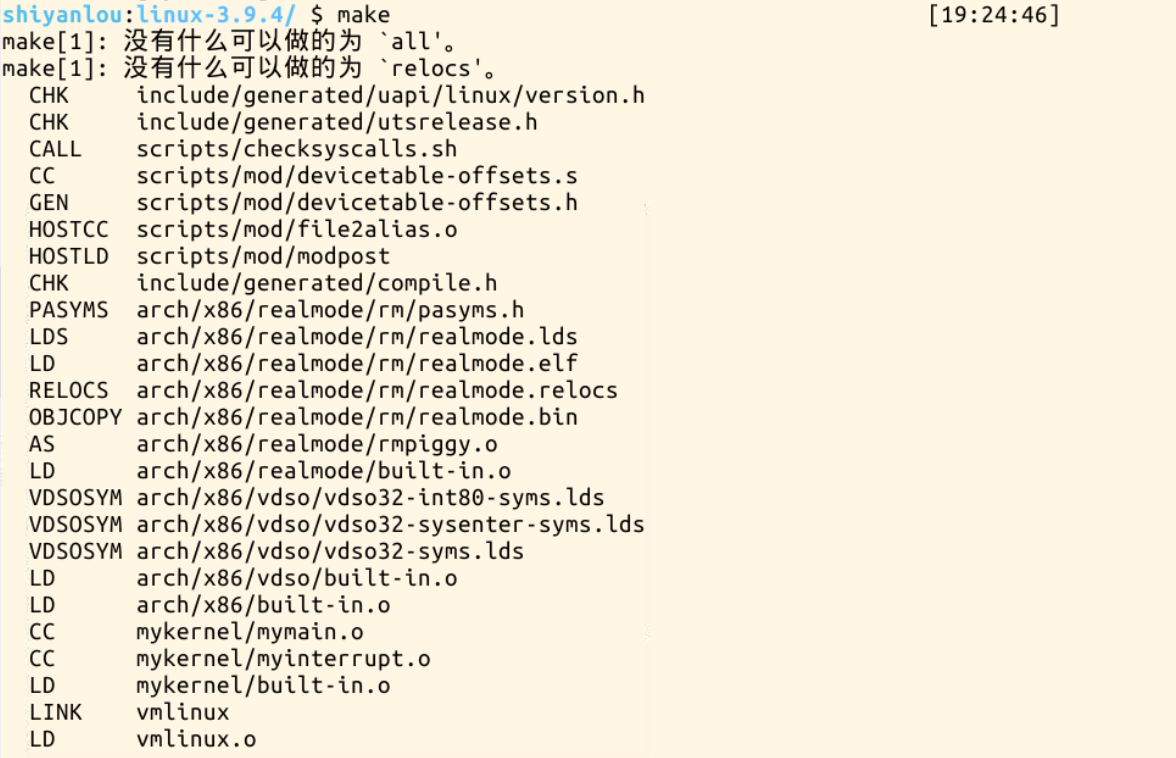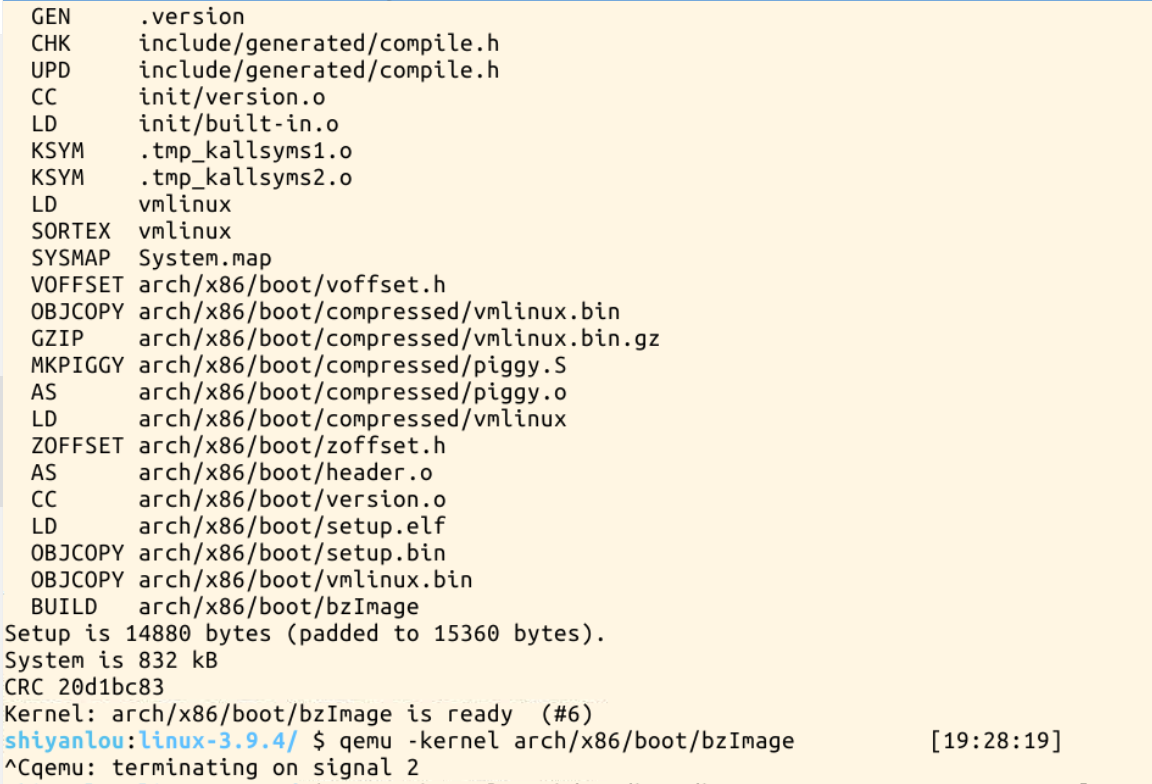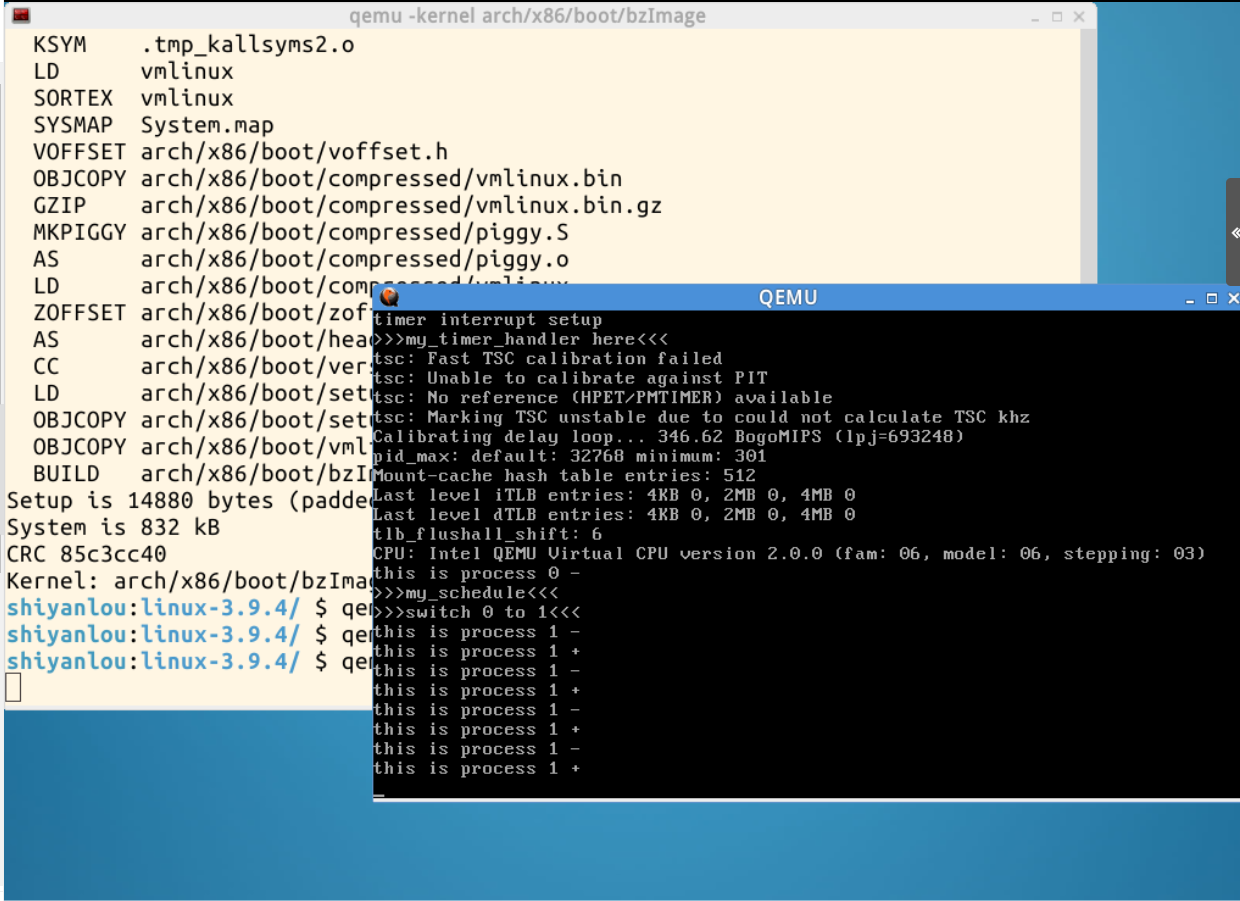一、课本知识
1.计算机的3个法宝:存储程序计算机、函数调用堆栈、中断机制
2.堆栈具体的作用有:记录函数调用框架、传递函数参数、保存返回值的地址、提供函数内部局部变量的存储空间等。
3.堆栈相关的寄存器:
ESP:堆栈指针,堆栈空间是从高地址向低地址增长的(X86体系结构)。
EBP:基址指针,在C语言中用作记录当前函数调用基址。
4.堆栈操作:
push:栈顶地址减少4个字节(32位),并将操作数放入栈顶存储单元。
pop: 栈顶地址增加4个字节(32位),并将栈顶存储单元的内容放入操作数。
5.其他操作
call:将当前CS:EIP的值压入栈顶,CS:EIP指向被调用函数的入口地址。
ret:从栈顶弹出原来保存在这里的CS:EIP的值,放入CS:EIP中。
6.对于x86 CPU,通过堆栈来传递参数的方法是从右到左依次压栈。
二、实验内容:完成一个简单的时间片轮转多道程序内核代码
1.实验代码
从mengning/mykernel下载代码
mypcb.h 定义进程控制块
/*
* linux/mykernel/mypcb.h
*
* Kernel internal PCB types
*
* Copyright (C) 2013 Mengning
*
*/
#define MAX_TASK_NUM 4
#define KERNEL_STACK_SIZE 1024*8
/* CPU-specific state of this task */
struct Thread {
unsigned long ip;
unsigned long sp;
};
typedef struct PCB{
int pid;
volatile long state; /* -1 unrunnable, 0 runnable, >0 stopped */
char stack[KERNEL_STACK_SIZE];
/* CPU-specific state of this task */
struct Thread thread;
unsigned long task_entry;
struct PCB *next;
}tPCB;
void my_schedule(void);
myinterrupt.c 其中my_schedule(void)函数:切换进程
/*
* linux/mykernel/myinterrupt.c
*
* Kernel internal my_timer_handler
*
* Copyright (C) 2013 Mengning
*
*/
#include <linux/types.h>
#include <linux/string.h>
#include <linux/ctype.h>
#include <linux/tty.h>
#include <linux/vmalloc.h>
#include "mypcb.h"
extern tPCB task[MAX_TASK_NUM];
extern tPCB * my_current_task;
extern volatile int my_need_sched;
volatile int time_count = 0;
/*
* Called by timer interrupt.
* it runs in the name of current running process,
* so it use kernel stack of current running process
*/
void my_timer_handler(void)
{
#if 1
if(time_count%1000 == 0 && my_need_sched != 1)
{
printk(KERN_NOTICE ">>>my_timer_handler here<<<
");
my_need_sched = 1;
}
time_count ++ ;
#endif
return;
}
void my_schedule(void)
{
tPCB * next;
tPCB * prev;
if(my_current_task == NULL
|| my_current_task->next == NULL)
{
return;
}
printk(KERN_NOTICE ">>>my_schedule<<<
");
/* schedule */ //next指针指向了下一号进程,prev指针指向了本进程
next = my_current_task->next;
prev = my_current_task;
if(next->state == 0)/* -1 unrunnable, 0 runnable, >0 stopped */ //0对应next进程执行过,
{
my_current_task = next;
printk(KERN_NOTICE ">>>switch %d to %d<<<
",prev->pid,next->pid);
/* switch to next process */
asm volatile(
"pushl %%ebp
" /* save ebp */ //保存当前进程esp到堆栈,保存进程上下文
"movl %%esp,%0
" /* save esp */ //保存当前esp到当前进程pcb中
"movl %2,%%esp
" /* restore esp */ //将next进程的堆栈栈顶的值存入esp寄存器
"movl $1f,%1
" /* save eip */ //保存当前进程的eip值,下次恢复进程后将在标号1开始执行
"pushl %3
" //将next进程继续执行的代码位置(标号1)压栈(next进程的堆栈)
"ret
" /* restore eip */ //出栈标号1到esp寄存器
"1: " /* next process start here */ //标号1,即next进程开始执行的位置
"popl %%ebp
" //恢复ebp寄存器的值
: "=m" (prev->thread.sp),"=m" (prev->thread.ip)
: "m" (next->thread.sp),"m" (next->thread.ip)
);
}
else //对应next进程第一次执行
{
next->state = 0;
my_current_task = next;
printk(KERN_NOTICE ">>>switch %d to %d<<<
",prev->pid,next->pid);
/* switch to new process */
asm volatile(
"pushl %%ebp
" /* save ebp */ //保存当前进程esp到堆栈,保存进程上下文
"movl %%esp,%0
" /* save esp */ //保存当前进程esp到pcb,保存进程上下文
"movl %2,%%esp
" /* restore esp */ //载入next进程的栈顶地址到esp寄存器,即将工作堆栈切换到next进程
"movl %2,%%ebp
" /* restore ebp */ //载入next进程的堆栈基址到ebp寄存器,由于next进程为一个新进程,堆栈为空
"movl $1f,%1
" /* save eip */ //保存当前eip寄存器值到pcb,$1f指向上面编号1,堆栈不变
"pushl %3
" //把即将执行的进程的代码入口地址入栈(next进程的堆栈)
"ret
" /* restore eip */ //出栈进程的代码入口地址到EIP寄存器
: "=m" (prev->thread.sp),"=m" (prev->thread.ip)
: "m" (next->thread.sp),"m" (next->thread.ip)
);
}
return;
}
mymain.c
/*
* linux/mykernel/mymain.c
*
* Kernel internal my_start_kernel
*
* Copyright (C) 2013 Mengning
*
*/
#include <linux/types.h>
#include <linux/string.h>
#include <linux/ctype.h>
#include <linux/tty.h>
#include <linux/vmalloc.h>
#include "mypcb.h"
tPCB task[MAX_TASK_NUM]; //定义4个进程
tPCB * my_current_task = NULL;
volatile int my_need_sched = 0;
void my_process(void);
void __init my_start_kernel(void)
{
int pid = 0;
int i;
/* Initialize process 0*/ //初始化0号进程
task[pid].pid = pid;
task[pid].state = 0;/* -1 unrunnable, 0 runnable, >0 stopped */ //0号进程为执行状态
task[pid].task_entry = task[pid].thread.ip = (unsigned long)my_process; //进程的入口为my_process
task[pid].thread.sp = (unsigned long)&task[pid].stack[KERNEL_STACK_SIZE-1];
task[pid].next = &task[pid];
/*fork more process */ //创建并初始化1,2,3号进程为就绪状态
for(i=1;i<MAX_TASK_NUM;i++)
{
memcpy(&task[i],&task[0],sizeof(tPCB));
task[i].pid = i;
task[i].state = -1;
task[i].thread.sp = (unsigned long)&task[i].stack[KERNEL_STACK_SIZE-1];
task[i].next = task[i-1].next;
task[i-1].next = &task[i];
}
/* start process 0 by task[0] */ //0号进程开始执行
pid = 0;
my_current_task = &task[pid];
asm volatile(
"movl %1,%%esp
" /* set task[pid].thread.sp to esp */ //esp寄存器指向进程0的栈底
"pushl %1
" /* push ebp */ //将当前ebp寄存器的值入栈,因为是空栈,esp与ebp相同
"pushl %0
" /* push task[pid].thread.ip */ //将当前eip入栈
"ret
" /* pop task[pid].thread.ip to eip */ //my_process(void)的位置放入eip中,0号进程启动,开始执行my_process(void)
"popl %%ebp
" //永不执行代码
:
: "c" (task[pid].thread.ip),"d" (task[pid].thread.sp) /* input c or d mean %ecx/%edx*/
);
}
void my_process(void)
{
int i = 0;
while(1)
{
i++;
if(i%10000000 == 0) //每当运行10000000 次后就会进行一次输出
{
printk(KERN_NOTICE "this is process %d -
",my_current_task->pid);
if(my_need_sched == 1) //time_count%1000 == 0 && my_need_sched != 1时时间中断调度
{
my_need_sched = 0;
my_schedule();
}
printk(KERN_NOTICE "this is process %d +
",my_current_task->pid);
}
}
}
2.编译程序并执行
$ make
$ qemu -kernel arch/x86/boot/bzImage



三、总结
Linux操作系统的正常工作可以说有三个非常重要的部分,就是存储程序原理、堆栈以及中断的支持。 操作系统对进程的管理主要就是进程的管理和调度,为每个进程维护一个进程描述和以及进程间的关系。内核的工作主要有两部分组成,首先运行有一个内核线程,然后就是一些中断处理程序的集合,在中断处理程序中要就行进程的调度。